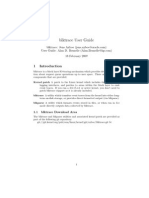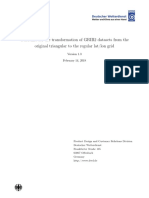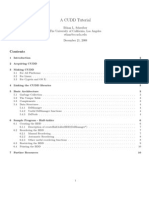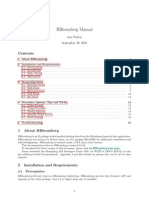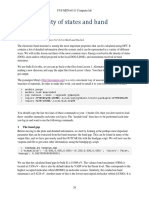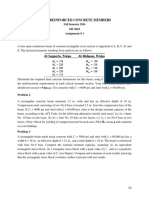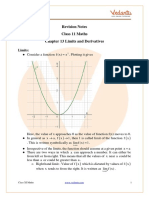LMGC90 UserGuide
LMGC90 UserGuide
Uploaded by
gpetitgeekCopyright:
Available Formats
LMGC90 UserGuide
LMGC90 UserGuide
Uploaded by
gpetitgeekOriginal Title
Copyright
Available Formats
Share this document
Did you find this document useful?
Is this content inappropriate?
Copyright:
Available Formats
LMGC90 UserGuide
LMGC90 UserGuide
Uploaded by
gpetitgeekCopyright:
Available Formats
LMGC90v2
User’s guide
2012
(CNRS) LMGC90 User’s Guide 2012 1 / 62
Outline
1 Introduction
2 DATBOX
3 OUTBOX
4 LMGC90 driver
5 Interaction laws description
6 Bulk behaviour parameters description
(CNRS) LMGC90 User’s Guide 2012 2 / 62
LMGC90 files - Introduction
A simulation is performed in a dedicated working directory, which contains various subdirectories :
DATBOX (mandatory) which contains all data files.
OUTBOX (mandatory) which contains all result files.
DISPLAY (optional) which contains visualization files (gmv or paraview).
It also contains a text file named DISPLAYED_GMV.
POSTPRO (optional) which contains post-processing file created during the simulation
process.
Data files may be generated using the LMGC90 PRE. Various examples are also given.
In this document we will explain the content of these files.
(CNRS) LMGC90 User’s Guide 2012 3 / 62
LMGC90 files - DATBOX
The different files necessary to describe the model are :
./DATBOX/BODIES.DAT sample description : geometry, models, etc.
./DATBOX/BULK_BEHAV.DAT bulk behaviour parameters
./DATBOX/TACT_BEHAV.DAT interaction law and visibilty rules
./DATBOX/DRV_DOF.DAT forces and driven degrees of freedom
./DATBOX/DOF.INI initial values of degrees of freedom of bodies
./DATBOX/Vloc_Rloc.INI initial values of interactions
./DATBOX/POSTPRO.DAT post-processing commands and parameters
For sample with deformable bodies, the following files must be added :
./DATBOX/MODELS.DAT numerical models
./DATBOX/GPV.INI initial values at gauss points
A file containing simulation commands and parameters is also necessary :
./command.py ChiPy python instructions
(CNRS) LMGC90 User’s Guide 2012 4 / 62
LMGC90 files - Output
The standard result files can be decomposed in 2 sets.
The first one came from the scanning of data files :
./OUTBOX/BODIES.OUT
./OUTBOX/BULK_BEHAV.OUT
./OUTBOX/TACT_BEHAV.OUT
./OUTBOX/MODELS.OUT
./OUTBOX/DRV_DOF.OUT
./OUTBOX/POSTPRO.OUT
This set of files is useful to check if data files have been read correctly.
The second one are database back-up files :
./OUTBOX/DOF.LAST
./OUTBOX/DOF.OUT.00p
./OUTBOX/GPV.LAST
./OUTBOX/GPV.OUT.00p
Using a set of these files, and copying it in the equivalent .INI files, allows to restart a simulation
from an existing initial solution.
(CNRS) LMGC90 User’s Guide 2012 5 / 62
LMGC90 files - Output
The visualisation files for gmv are :
./DISPLAY/DISPLAYED_GMV stores the rank of the last gmv file written
./DISPLAY/agmv.out.xxxx asciii file
./DISPLAY/bgmv.out.xxxx binary file
The visualisation files for paraview are :
./DISPLAY/a_rbdy3_xxxxxx.vtu data stored/computed at centers of inertia of a RBDY3
./DISPLAY/a_mailx_xxxxxx.vtu data stored/computed at nodes of MAILx
./DISPLAY/a_tact_xxxxxx.vtu data stored/computed on contactor
./DISPLAY/a_inter_xxxxxx.vtu data stored/computed at interaction
For post-processing files, the reader could refer to the specific documentation
(Manuals/LMGC90_Postpro.pdf).
(CNRS) LMGC90 User’s Guide 2012 6 / 62
DATBOX : : BODIES.DAT
This text file gathers the description of rigid bodies or deformable bodies, together with their bulk
properties, degrees of freedom and contactors.
The data are formatted and read as follows :
The symbol ’$’ preceeds a keyword used in scanning files.
The symbol ’bdyty’ stands for ’body type data’.
These data are distributed according to the following species.
The specy ’blmty’ stands for ’bulk element type data’, i.e. part
or total bulk geometric description, and bulk behaviour laws;
The specy ’nodty’ stands for ’node type data’,i.e. degrees of
freedom data;
The specy ’tacty’ stands for ’contactor type data’;
The keyword ’$$$$$$’ ends a body record.
The BODIES.DAT file is made of a collection of “cards” described as previously.
A line starting with # or ! is a comment.
(CNRS) LMGC90 User’s Guide 2012 7 / 62
DATBOX : : BODIES.DAT
To describe a 2D rigid body (RBDY2) with 2 boundaries :
!234567890123456789012345678901234567890123456789012345678901234567890123456789012345678901234567890
$bdyty
RBDY2 1
$blmty
PLAIN 1 behav PLEXx avrd= 0.1600000D-02 gyrd= 0.1131200D-02
$nodty
NO3xx 1 coo1= 0.5808000D-01 coo2= 0.4928000D-01 coo3= 0.0000000D+00
$tacty
DISKx 1 color BLEUx byrd= 0.1600000D-02
xKSID 2 color REDxx byrd= 0.1600000D-01
$$$$$$
avrd and gyrd allow to compute the mass and inertia of the body, independantly of the shape
of the contactors. If these parameters are set to 0, LMGC90 try to compute them using the
shapes of the contactors. In this last case LMGC90 doesn’t manage overlaps of contactors.
usually contactors are described relatively to the center of inertia frame. If the nodal
coordinates are set equal to 0, it means that the contactors are defined relatively to the global
frame. In this case the center of inertia frame is rebuild. You may specify as many contactors
as you want.
(CNRS) LMGC90 User’s Guide 2012 8 / 62
DATBOX : : BODIES.DAT
Available boundaries for RBDY2 are :
DISKx, full disc :
!234567890123456789012345678901234567890123456789012345678901234567890123456789012345678901234567890
DISKx 1 color BLEUx byrd= 0.1600000D-02
xKSID, hollow disc :
!234567890123456789012345678901234567890123456789012345678901234567890123456789012345678901234567890
xKSID 1 color BLEUx byrd= 0.1600000D-02
DISPx, full pneumatic disc :
!234567890123456789012345678901234567890123456789012345678901234567890123456789012345678901234567890
DISPx 1 color BLEUx byrd= 0.1600000D-02
xPSID, hollow pneumatic disc :
!234567890123456789012345678901234567890123456789012345678901234567890123456789012345678901234567890
xPSID 1 color BLEUx byrd= 0.1600000D-02
DISKb, full excentred disc :
!234567890123456789012345678901234567890123456789012345678901234567890123456789012345678901234567890
DISKb 1 color BLEUx byrd= 0.1600000D-02
coo1= 0.9999582D+00 coo2=-0.0091384D+00
(CNRS) LMGC90 User’s Guide 2012 9 / 62
DATBOX : : BODIES.DAT
Available Boundaries for RBDY2 are :
JONCx, full wall :
!234567890123456789012345678901234567890123456789012345678901234567890123456789012345678901234567890
JONCx 1 color UPxxx ax1 = 0.5000000D+02 ax2 = 0.1000000D+01
POLYG, full polygon :
!234567890123456789012345678901234567890123456789012345678901234567890123456789012345678901234567890
POLYG 1 color BLEUx nb_vertex= 5 byrd= 0.7250500D+01
coo1=-0.3561507D+00 coo2= 0.5481881D-01
coo1=-0.3561979D+00 coo2= 0.6334220D-01
coo1=-0.3643187D+00 coo2= 0.6593115D-01
coo1=-0.3692904D+00 coo2= 0.5900783D-01
coo1=-0.3642423D+00 coo2= 0.5214002D-01
PT2Dx, a point :
!234567890123456789012345678901234567890123456789012345678901234567890123456789012345678901234567890
PT2Dx 2 color BLEUx coo1= 0.0000000D+00 coo2= 0.0000000D+00
(CNRS) LMGC90 User’s Guide 2012 10 / 62
DATBOX : : BODIES.DAT
To describe a 3D rigid body (RBDY3) :
!234567890123456789012345678901234567890123456789012345678901234567890123456789012345678901234567890
$bdyty
RBDY3 1
$blmty
PLAIN 1 behav xxxxx avrd= 0.2081680D-03
$nodty
NO6xx 1 coo1=-0.2969270D-02 coo2=-0.2851180D-02 coo3= 0.3336920D-03
coo4= 0.0000000D+00 coo5= 0.0000000D+00 coo6= 0.0000000D+00
$tacty
SPHER 1 color bleu_ byrd= 0.2081680D-03
$$$$$$
(CNRS) LMGC90 User’s Guide 2012 11 / 62
DATBOX : : BODIES.DAT
Available Boundaries for RBDY3 are :
SPHER, full sphere :
!234567890123456789012345678901234567890123456789012345678901234567890123456789012345678901234567890
SPHER 1 color bleu_ byrd= 0.2081680D-03
CYLND, full cylinder :
!234567890123456789012345678901234567890123456789012345678901234567890123456789012345678901234567890
CYLND 1 color GREE1 High= 0.2000000D+02 byrd= 0.2000000D+01
DNLYC, hollow cylinder :
!234567890123456789012345678901234567890123456789012345678901234567890123456789012345678901234567890
DNLYC 1 color GREE1 High= 0.2000000D+02 byrd= 0.2000000D+01
(CNRS) LMGC90 User’s Guide 2012 12 / 62
DATBOX : : BODIES.DAT
Available Boundaries for RBDY3 are :
cluster of spheres :
$bdyty
RBDY3 1
$blmty
PLAIN 1 behav PLEX3 avrd= 0.0000000D+00
$nodty
NO6xx 1 coo1= 0.0000000D-01 coo2= 0.0000000D-01 coo3= 0.0000000D-01
coo4= 0.0000000D+00 coo5= 0.0000000D+00 coo6= 0.0000000D+00
$tacty
SPHEb 1 color BLEUx byrd= 0.5000000D-02
coo1= 0.2500000D-02 coo2= 0.4330127D-02 coo3= 0.5000000D-02
SPHEb 1 color BLEUx byrd= 0.5000000D-02
coo1=-0.5000000D-02 coo2= 0.0000000D-02 coo3= 0.5000000D-02
SPHEb 1 color BLEUx byrd= 0.5000000D-02
coo1= 0.2500000D-02 coo2=-0.4330127D-02 coo3= 0.5000000D-02
SPHEb 1 color BLEUx byrd= 0.5000000D-02
coo1= 0.0000000D-02 coo2= 0.0000000D-02 coo3= 1.3660254D-02
$$$$$$
(CNRS) LMGC90 User’s Guide 2012 13 / 62
DATBOX : : BODIES.DAT
Available Boundaries for RBDY3 are :
POLYR, full polyedra :
!234567890123456789012345678901234567890123456789012345678901234567890123456789012345678901234567890
POLYR 1 color BLEU1 nb_vertex= 8 nb_face= 12
coo1= 0.1000000D+01 coo2= 0.1000000D+01 coo3= 0.1000000D+01
coo1= 0.1000000D+01 coo2= 0.2000000D+01 coo3= 0.1000000D+01
coo1= 0.1000000D+01 coo2= 0.2000000D+01 coo3= 0.0000000D+00
coo1= 0.1000000D+01 coo2= 0.1000000D+01 coo3= 0.0000000D+00
coo1= 0.3000000D+01 coo2= 0.2000000D+01 coo3= 0.1000000D+01
coo1= 0.3000000D+01 coo2= 0.2000000D+01 coo3= 0.0000000D+00
coo1= 0.3000000D+01 coo2= 0.1000000D+01 coo3= 0.1000000D+01
coo1= 0.3000000D+01 coo2= 0.1000000D+01 coo3= 0.0000000D+00
ver1= 1 ver2= 2 ver3= 3
ver1= 1 ver2= 3 ver3= 4
ver1= 2 ver2= 5 ver3= 6
ver1= 2 ver2= 6 ver3= 3
ver1= 5 ver2= 7 ver3= 8
ver1= 5 ver2= 8 ver3= 6
ver1= 1 ver2= 4 ver3= 8
ver1= 1 ver2= 8 ver3= 7
ver1= 3 ver2= 6 ver3= 8
ver1= 3 ver2= 8 ver3= 4
ver1= 1 ver2= 2 ver3= 5
ver1= 1 ver2= 5 ver3= 7
PLANx, plane :
!234567890123456789012345678901234567890123456789012345678901234567890123456789012345678901234567890
PLANx 1 color VERTx axe1= 0.0100000D+03 axe2= 0.0100000D+03 axe3= 0.0000100D+03
PT3Dx, point :
!234567890123456789012345678901234567890123456789012345678901234567890123456789012345678901234567890
PT3Dx 2 color TYTYx coo1= 0.0000000D+00 coo2= 0.0000000D+00 coo3= 0.0000000D+00
(CNRS) LMGC90 User’s Guide 2012 14 / 62
DATBOX : : BODIES.DAT
To describe a 2D deformable body (MAILx) with a boundary :
!234567890123456789012345678901234567890123456789012345678901234567890123456789012345678901234567890
$bdyty
MAILx 1
$blmty
Q4xxx 1 nodes 1 3 4 2
model M2DNL behav Steel
$nodty
NO2xx 1 coo1= 0.0000000D+00 coo2= 0.0000000D+00
NO2xx 2 coo1= 0.0000000D+00 coo2= 0.1000000D+01
NO2xx 3 coo1= 0.1000000D+01 coo2= 0.0000000D+00
NO2xx 4 coo1= 0.1000000D+01 coo2= 0.1000000D+01
$tacty
ALpxx 1 color REDxx noda= 2 nodb= 4
$$$$$$
$bdyty
MAILx 2
$blmty
Q4xxx 1 nodes 1 3 4 2
model M2DNL behav Steel
$nodty
NO2xx 1 coo1= 0.0000000D+00 coo2= 0.1000000D+01
NO2xx 2 coo1= 0.0000000D+00 coo2= 0.2000000D+01
NO2xx 3 coo1= 0.1000000D+01 coo2= 0.1000000D+01
NO2xx 4 coo1= 0.1000000D+01 coo2= 0.2000000D+01
$tacty
CLxxx 1 color REDxx noda= 3 nodb= 1 apab= 0.5000000D+00
$$$$$$
you may define “continuous” line :
$tacty
ALpxx 1 color REDxx noda= 2 nodb= 4
+ALpxx 1 color REDxx noda= 4 nodb= 5
+ALpxx 1 color REDxx noda= 5 nodb= 6
the 2D boundaries must be defined clockwise
(CNRS) LMGC90 User’s Guide 2012 15 / 62
DATBOX : : BODIES.DAT
Available Boundaries for 2D MAILx are :
CLxxx, candidate point on a line :
!234567890123456789012345678901234567890123456789012345678901234567890123456789012345678901234567890
CLxxx 1 color REDxx noda= 3 nodb= 1 apab= 0.5000000D+00
ALpxx, antagoniste line :
!234567890123456789012345678901234567890123456789012345678901234567890123456789012345678901234567890
ALpxx 1 color REDxx noda= 2 nodb= 4
PT2Dl, point on a line :
!234567890123456789012345678901234567890123456789012345678901234567890123456789012345678901234567890
PT2Dl 1 color REDxx noda= 3 nodb= 1 apab= 0.5000000D+00
DISKL, full disc :
!234567890123456789012345678901234567890123456789012345678901234567890123456789012345678901234567890
DISKL 1 color BLEUx noda= 4 nodb= 3 apab= 0.5000000D+00 byrd= 0.1000000D+00
(CNRS) LMGC90 User’s Guide 2012 16 / 62
DATBOX : : BODIES.DAT
Available Boundaries for 3D MAILx are :
CSxx3 and CSxx4 candidate point on a surface :
!234567890123456789012345678901234567890123456789012345678901234567890123456789012345678901234567890
CSxx3 1 color REDxx noda= 3 nodb= 1 nodc= 2
w1 = 0.1000000D+00 w2 = 0.5000000D+00 w3 = 0.4000000D+00
!
CSxx4 1 color REDxx noda= 3 nodb= 1 nodc= 2 nodd= 4
w1 = 0.2500000D+00 w2 = 0.2500000D+00 w3 = 0.2500000D+00
w4 = 0.2500000D+00
ASpx3 and ASpx4 antagoniste surface :
!234567890123456789012345678901234567890123456789012345678901234567890123456789012345678901234567890
ASpx3 1 color REDxx noda= 3 nodb= 1 nodc= 2
!
ASpx4 1 color REDxx noda= 3 nodb= 1 nodc= 2 nodd= 4
(CNRS) LMGC90 User’s Guide 2012 17 / 62
DATBOX : : TACT_BEHAV.DAT
This file contains two types of cards :
some describing the interaction laws
!234567890123456789012345678901234567890123456789012345678901234567890123456789012345678901234567890
$behav lawty
iqsc0 IQS_CLB fric= 0.9500000D+00
some describing the visibility tables :
!234567890123456789012345678901234567890123456789012345678901234567890123456789012345678901234567890
$seety
cdbdy cdtac cdcol behav anbdy antac ancol alert
RBDY3 PT3Dx TYTYx BIOff RBDY3 PT3Dx TYTYx 0.5000000D+02
(CNRS) LMGC90 User’s Guide 2012 18 / 62
DATBOX : : TACT_BEHAV.DAT
The list of all interaction law is the following :
Rigid/Rigid
IQS_CLB IQS_DS_CLB IQS_CLB_RGR
IQS_MOHR_DS_CLB IQS_WET_DS_CLB xQS_WET_DS_CLB
IQS_MAC_CZM IQS_SGR_CLB_WEAR
IQS_CLB_nosldt IQS_CLB_noslds
IQS_MAC_CZM_3D_nosldt IQS_MAC_CZM_3D_noslds IQS_MAC_CZM_3D
RST_CLB RST_DS_CLB
ELASTIC_WIRE ELASTIC_ROD
VOIGT_WIRE VOIGT_ROD
ELASTIC_REPELL_CLB ELASTIC_REPELL_WET_CLB CRITICAL_VOIGT_CLB
COUPLED_DOF PLASTIC_COUPLED_DOF NORMAL_COUPLED_DOF
TANGENTIAL_COUPLED_DOF TEX_SOL_UNILAT
MD_JKRs DEM_Cohe_Hertz
PERIO_DOF
Rigid/Defo and Defo/Defo
GAP_SGR_CLB GAP_SGR_DS_CLB GAP_WET_DS_CLB
VEL_SGR_CLB VEL_SGR_DS_CLB
GAP_SGR_CLB_WEAR
MAC_CZM MAC_CZM_3D_nosldt MAC_CZM_3D_noslds
(CNRS) LMGC90 User’s Guide 2012 19 / 62
DATBOX : : BULK_BEHAV.DAT
This file contains values of some bulk parameters
the fact you give some bulk parameters doesn’t imply any thing on the way the computation
run (see MODELS.DAT and command files)
you have to give the gravity field :
$gravy
grv1=-0.0000000D+01 grv2= 0.0000000D+01 grv3=-0.9810000D+01
then it works with filters which imply to define subset of parameters :
á rigid bulk parameters :
$behav lawty
tdurx RIGID Umas= 0.2500000D+04
á elastic bulk parameters :
$behav lawty
Steel ELAS Umas= 0.7800000D-08
elas: standard
ani_: isotropic
EYng= 0.2000000D+06 EPss= 0.3000000D+00
(CNRS) LMGC90 User’s Guide 2012 20 / 62
DATBOX : : BULK_BEHAV.DAT
The known filters
RIGID
ELAS
ELAS_DILA
ELAS_PLAS
VISCO_ELAS
THERMO_ELAS
THERMO_ELAS_VARIA
THERMO_RIGID
ELECTRO_RIGID
THERMO_ELECTRO_RIGID
(CNRS) LMGC90 User’s Guide 2012 21 / 62
DATBOX : : MODELS.DAT
see zooef.pdf file.
(CNRS) LMGC90 User’s Guide 2012 22 / 62
DATBOX : : DRV_DOF.DAT
Contains the description of imposed (driven) degrees of freedom.
$bdyty
RBDY2 1
$nodty
NO3xx 1
$dofty [CT......+......AMP..*..cos.(..OMEGA.*.time.+.PHI..)]...*...[RAMPI.....+.....RAMP.*.time]
vlocy 1 0.1000000D+00 0.5460000D+00 0.3140000D+00 0.0000000D+00 0.5000000D+00 0.1000000D-01
force 2 -0.6837000D+00 0.0000000D+00 0.0000000D+00 0.0000000D+00 0.1000000D+01 0.0000000D+00
vlocy 3 0.0000000D+00 0.0000000D+00 0.0000000D+00 0.0000000D+00 0.1000000D+01 0.0000000D+00
$$$$$$
$bdyty
RBDY2 3
$nodty
NO3xx 1
$dofty [CT......+......AMP..*..cos.(..OMEGA.*.time.+.PHI..)]...*...[RAMPI.....+.....RAMP.*.time]
vlocy 1 evolution vx.dat
vlocy 3 0.0000000D+00 0.0000000D+00 0.0000000D+00 0.0000000D+00 0.1000000D+01 0.0000000D+00
$$$$$$
Consider the 2D rigid body 1 (RBDY2) equipped with a 3 degrees of freedom node NO3xx.
The degrees of freedom number 1, 3 are submitted to imposed velocities, keyword vlocy.
The degree of freedom number 2 is submitted to an imposed force, keyword force.
(CNRS) LMGC90 User’s Guide 2012 23 / 62
DATBOX : : DRV_DOF.DAT
The imposed velocities or forces are :
described by a function :
V = (C + A ∗ cos(ω ∗ (t + φ)) ∗ sign(ramp(t)) ∗ min(1, kramp(t)k),
C, A, ω, φ, are scalar constants ,
ramp(t) = RI + RP ∗ t is an affine function,
RI, RP, are scalar constants.
described by an evolution file
t0 v (t0 )
t1 v (t1 )
...
tn v (tn )
(CNRS) LMGC90 User’s Guide 2012 24 / 62
The INI files
DATBOX : :DOF.INI
It describes the displacements,
DATBOX : :Vloc_Rloc.INI
DATBOX : :GPV.INI
(CNRS) LMGC90 User’s Guide 2012 25 / 62
OUTBOX : : DOF.OUT
This text files contain the degrees of freedom results with the same format and meaning than
DOF.INI. These files are written in the subdirectory OUTBOX as called by the following user
commands :
The user command WRITE LAST DOF writes the last computed record of X , V in the output
file OUTBOX/DOF.LAST.
The user command WRITE OUT DOF STEP p writes the computed record of X , V at step
modulo p (some integer) in the output file OUTBOX/DOF.OUT.int(nstep/p), i.e. the files are
numbered int(nstep/p) the integer part of the ratio nstep/p, where nstep is the current step
number.
(CNRS) LMGC90 User’s Guide 2012 26 / 62
OUTBOX : : Vloc_Rloc.OUT
(CNRS) LMGC90 User’s Guide 2012 27 / 62
OUTBOX : : GPV.OUT
(CNRS) LMGC90 User’s Guide 2012 28 / 62
ChiPy
Have a look to Manuals/ChiPy.pdf and Docs/ChiPy.html
(CNRS) LMGC90 User’s Guide 2012 29 / 62
postmortem
Restart
Visualisation
(CNRS) LMGC90 User’s Guide 2012 30 / 62
IQS_CLB
TACT_BEHAV.DAT synopsis:
#2345678901234567890123456789012345678901234567890123456789012345678901234567890
$behav lawty
iqsc1 IQS_CLB fric= 0.5000000D+00
comments:
This contact law is used to describe an Inelastic Quasi Shock law coupled with the Coulomb’s
friction law (CLB) . This inelastic shock law is appropriate to simulate large deformation problems
of compact collections of rigid bodies. The normal part is describe by the classical linear
complementarity problem (Signorini condition) :
g ≥ 0 RN ≥ 0 g · RN = 0
and the tangential part by the classical Coulomb condition :
RT
kRT k ≤ µRN if kRT k = µRN then UT = −λ with λ > 0 else UT = 0
kRT k
The only coefficient defining this law is the friction coefficient µ (fric). Note that when contactors
are approaching it allows a relative velocity to impose a null gap after the resolution. Otherwise a
null relative velocity is imposed.
back to tact_behav list
(CNRS) LMGC90 User’s Guide 2012 31 / 62
IQS_CLB_RGR
TACT_BEHAV.DAT synopsis:
#2345678901234567890123456789012345678901234567890123456789012345678901234567890
$behav lawty
irgr1 IQS_CLB_RGR T/H = 0.5000000D+00 gtol= 0.1000000D-04
fric= 0.2000000D+00
comments:
This contact law is used to describe an Inelastic Quasi Shock law coupled with the Coulomb’s
friction law (CLB) with an articial artifact allowing a mild gap violation restoring procedure so called
Radjai Gap Rescue. This law is defined through three coefficient : the friction coefficient µ (fric), a
gap tolerance gtol , and a articial damping parameter τh .
If the gap g(ti ), resulting of the previous contact resolution is greater than the gap tolerance then
the standard IQS_CLB law is applied. Otherwise an artificial repulsive force is applied to body in
contact to retrieve a gap that respect the given gap tolerance :
∗ π2 (g(ti ) − gtol )
RN = −2
Wnnτh2 h
back to tact_behav list
(CNRS) LMGC90 User’s Guide 2012 32 / 62
IQS_DS_CLB
TACT_BEHAV.DAT synopsis:
#2345678901234567890123456789012345678901234567890123456789012345678901234567890
$behav lawty
idsc1 IQS_DS_CLB dyfr= 0.3000000D+00 stfr= 0.5000000D+00
comments:
This contact law is used to describe an Inelastic Quasi Shock law coupled with a Dynamic/Static
Coulomb’s friction law (CLB) . The IQS_CLB formalism is used but the Coulomb’s law is equipped
with a static friction coefficient stfr when the status at the beginning of the time step is stick and a
dynamical friction coefficient dyfr otherwise.
back to tact_behav list
(CNRS) LMGC90 User’s Guide 2012 33 / 62
GAP_SGR_CLB
TACT_BEHAV.DAT synopsis:
#2345678901234567890123456789012345678901234567890123456789012345678901234567890
$behav lawty
gapc1 GAP_SGR_CLB fric= 0.5000000D+00
comments:
The Signorini condition involving the gap is used as a unilateral constraint, together with
Coulomb’s law. This Signorini condition is a complementary condition between the gap and the
normal reaction impulse. The only coefficient defining this law is the friction coefficient fric.
This law may be used in quasi-static situations when one of the contactor is deformable. When
dynamical problems between rigid bodies are under consideration, this law which has the property
to correct penetrations within a single step introduces correcting impulses well up to cause artifact
burst. This law is not recommended to deal with dynamical contact between rigid bodies.
back to tact_behav list
(CNRS) LMGC90 User’s Guide 2012 34 / 62
GAP_SGR_DS_CLB
TACT_BEHAV.DAT synopsis:
#2345678901234567890123456789012345678901234567890123456789012345678901234567890
$behav lawty
gdsc1 GAP_SGR_DS_CLB dyfr= 0.3000000D+00 stfr= 0.5000000D+00
comments:
This contact law is an enrichment fo the law GAP_SGR_CLB except that static stfr and dynamic
dyfr friction coefficients are considered. The Coulomb’s law is equipped with the static coefficient
when the status at the beginning of the time step is stick, otherwise the dynamical friction
coefficient is used.
back to tact_behav list
(CNRS) LMGC90 User’s Guide 2012 35 / 62
VEL_SGR_CLB
TACT_BEHAV.DAT synopsis:
#2345678901234567890123456789012345678901234567890123456789012345678901234567890
$behav lawty
velc1 VEL_SGR_CLB fric= 0.5000000D+00
comments:
When a contact is fore-casted, a complementary condition between the normal relative velocity
and the normal reaction impulse is used, together with Coulomb’s law. Such a law implies that
unilateral constraints are satisfied (J.J. Moreau). The only coefficient defining this law is the friction
coefficient fric.
This law may be used in quasi-static situations when one of the contactor is deformable. When
dynamical problems between rigid bodies are under consideration, this law which has the property
to correct penetrations within a single step introduces correcting impulses well up to cause artifact
burst. This law is not recommended to deal with dynamical contact between rigid bodies. This laws
is appropriate to deal with dynamical contacts between rigid or deformable contactors. It acts as
an inelastic shock law.
back to tact_behav list
(CNRS) LMGC90 User’s Guide 2012 36 / 62
VEL_SGR_DS_CLB
TACT_BEHAV.DAT synopsis:
#2345678901234567890123456789012345678901234567890123456789012345678901234567890
$behav lawty
vdsc1 VEL_SGR_DS_CLB dyfr= 0.5000000D+00 stfr= 0.6000000D+00
comments:
This contact law is an enrichment to VEL_SGR_CLB except that static stfr and dynamic dyfr
friction coefficients are considered. The Coulomb’s law is equipped with the static coefficient when
the status at the beginning of the time step is stick, otherwise the dynamical friction coefficient is
used.
back to tact_behav list
(CNRS) LMGC90 User’s Guide 2012 37 / 62
RST_CLB
TACT_BEHAV.DAT synopsis:
#2345678901234567890123456789012345678901234567890123456789012345678901234567890
$behav lawty
rstc1 RST_CLB rstn= 0.9000000D+00 rstt 0.5000000D+00
fric= 0.0000000D+00
comments:
When a contact is fore-casted, a restitution shock law involving the relative velocity before the
impact time (at the beginning of the time step) and after the impact time (at the end of the time
step) is imposed. This law is a generalization by J.J. Moreau of the classical Newton restitution
law. A normal restitution rstn and a tangential restitution coefficient rstt are used. This shock law
is used together with Coulomb’s law, with a friction coefficient fric.
This law may be used between impacting rigid bodies in granular flows. There are experimental
results proving that this law is relevant for impacting spheres. Nevertheless, the concept of shock
law, a limit law when waves propagation and complex local deformation phenomena occur is not
ascertained. This simple shock law should not be used when the aspect ratio of contactors is high
(...more than 5. or ?). Inelastic shock laws prove to be dissipative in any circumstances, which is
not the case with this restitution law.
back to tact_behav list
(CNRS) LMGC90 User’s Guide 2012 38 / 62
RST_DS_CLB
TACT_BEHAV.DAT synopsis:
#2345678901234567890123456789012345678901234567890123456789012345678901234567890
$behav lawty
rdsc1 RST_DS_CLB rstn= 0.9000000D+00 rstt= 0.5000000D+00
dyfr= 0.3000000D+00 stfr= 0.5000000D+00
comments:
This contact law is an enrichment to RST_CLB except that static stfr and dynamic dyfr friction
coefficients are considered. The Coulomb’s law is equipped with the static coefficient when the
status at the beginning of the time step is stick, otherwise the dynamical friction coefficient is used.
back to tact_behav list
(CNRS) LMGC90 User’s Guide 2012 39 / 62
IQS_MOHR_DS_CLB
TACT_BEHAV.DAT synopsis:
#2345678901234567890123456789012345678901234567890123456789012345678901234567890
$behav lawty
mohr1 IQS_MOHR_DS_CLB cohn= 0.9000000D+01 coht= 0.5000000D+00
dyfr= 0.2500000D+00 stfr= 0.5500000D+00
comments:
This contact law is the Mohr Coulomb law when the status at the beginning of the time step is
cohesive statusBEGIN = Mstck, otherwise the contact law is IQS_DS_CLB. The coefficients cohn
and coht stand for normal and tangential cohesion thresholds, so that the Mohr-Coulomb cone
has an opening angle φ, tgφ = coht/cohn. Note that this law has been used formerly. It has to
be checked again.
back to tact_behav list
(CNRS) LMGC90 User’s Guide 2012 40 / 62
IQS_WET_DS_CLB
TACT_BEHAV.DAT synopsis:
#2345678901234567890123456789012345678901234567890123456789012345678901234567890
$behav lawty
wet01 IQS_WET_DS_CLB cohn= 0.2234379D+01 coht= 0.2234379D+01
Wthk= 0.1000000D-02
dyfr= 0.2500000D+00 stfr= 0.5500000D+00
comments:
This contact law takes into account cohesion between contactors, as a Lennard Jones law would
do, but in the non smooth style. When the gap at the beginning of the time step is less than some
given data, gapBEGIN ≤ Wthk, an cohesive law is applied. Otherwise a IQS_DS_CLB law is
applied :
If gapBEGIN ≥ Wthk then g ≥ 0 RN ≥ 0 g · RN = 0
else (g) ≥ 0 (RN + cohn) ≥ 0 g · (RN + cohn) = 0
The status resulting from the contact resolution could be Wstck (Wet sticking), Wslfw (Wet sliding
forward), Wslbw (Wet sliding backward) or Wnctc (Wet no contact). For the next steps, cohesion is
active as long as the gap remains less than the given value Wthk. When the detachment has
occurred, gap ≥ Wthk, the adhesive status is lost and the law IQS_DS_CLB is applied. The
adhesive process is active again if the gap appears to be less than Wthk. On the whole, the
energy to separate the contactors is cohn*Wthk.
The coefficients dyfr and stfr stand for dynamic and static friction coefficient.
back to tact_behav list
(CNRS) LMGC90 User’s Guide 2012 41 / 62
xQS_WET_DS_CLB
TACT_BEHAV.DAT synopsis:
#2345678901234567890123456789012345678901234567890123456789012345678901234567890
$behav lawty
wet01 xQS_WET_DS_CLB cohn= 0.2234379D+01 coht= 0.2234379D+01
Wthk= 0.1000000D-02
dyfr= 0.2500000D+00 stfr= 0.5500000D+00
comments:
This contact law takes into account adhesion between contactors, as a Lennard Jones law would
do, but in the non smooth style. When the gap at the beginning of the time step is less than some
given data, gapBEGIN ≤ Wthk, an cohesive law is applied. Otherwise a IQS_DS_CLB law is
applied :
If gapBEGIN ≥ Wthk then g ≥ 0 RN ≥ 0 g · RN = 0
else (g) ≥ 0 (RN + cohn) ≥ 0 g · (RN + cohn) = 0
The coefficients dyfr and stfr stand for dynamic and static friction coefficient. Contrary to the
xQS_WET_DS_CL law, this one present an irreversible feature of cohesion. When the cohesive
contact is broken, it could not be again cohesive adn the law acts as the IQS_DS_CLB law.
back to tact_behav list
(CNRS) LMGC90 User’s Guide 2012 42 / 62
GAP_WET_DS_CLB
TACT_BEHAV.DAT synopsis:
#2345678901234567890123456789012345678901234567890123456789012345678901234567890
$behav lawty
wet01 GAP_WET_DS_CLB cohn= 0.2234379D+01 coht= 0.2234379D+01
Wthk= 0.1000000D-02
dyfr= 0.2500000D+00 stfr= 0.5500000D+00
comments: :
This contact law takes into account adhesion between contactors, as a Lennard Jones law would
do, but in the non smooth style. When the gap at the beginning of the time step is less than some
given data, gapBEGIN ≤ Wthk, an cohesive law is applied. Otherwise a GAP_DS_CLB law is
applied.
This law may be used in quasi-static situations when one of the contactor is deformable. When
dynamical problems between rigid bodies are under consideration, this law which has the property
to correct penetrations within a single step introduces correcting impulses well up to cause artifact
burst. This law is not recommended to deal with dynamical contact between rigid bodies.
back to tact_behav list
(CNRS) LMGC90 User’s Guide 2012 43 / 62
ELASTIC_REPELL_CLB
TACT_BEHAV.DAT synopsis:
#2345678901234567890123456789012345678901234567890123456789012345678901234567890
$behav lawty
erpcE ELASTIC_REPELL_CLB F/gp= 0.4000000D+05
fric= 0.8391000D+00
comments:
This law describes a normal reaction force proportional to the gap (interpenetration), otherwise the
reaction force vanishes when the contactors separate (positive gap). The friction law is Coulomb’s
law. Coulomb’s law. The stiffness between contactors is described by the coefficient F/gp i.e. a
force per unit length (of gap). The coefficient fric is the friction coefficient. This law is useful when
there are physical reasons to take elasticity in consideration, for instance one of the contactor is
soft. Be aware of the fact that dynamical effects (oscillations of the contactors) may occur if the
time step is soft enough.
back to tact_behav list
(CNRS) LMGC90 User’s Guide 2012 44 / 62
ELASTIC_WIRE
TACT_BEHAV.DAT synopsis:
#2345678901234567890123456789012345678901234567890123456789012345678901234567890
$behav lawty
elawr ELASTIC_WIRE F/st= 0.5000000D+01 prst=-0.5000000D-01
comments:
This law describes the behaviour of an elastic wire connecting two contactors, usually points
PT2Dx, but actually any kind of contactors. The reaction force when the wire is under tension is
proportional to the deformation, otherwise the wire does not present any compression and the
reaction force vanishes.The reaction force writes,
RlocN = −F /st ∗ strain,
with
strain = (gapTT − gapREF )/gapREF − prst,
where gapREF is the gap between contactors in the reference configuration, i.e. the configuration
resulting of the combination of the BODIES.DAT and DOF.INI.
Remark : This law involving elasticity is treated as a so called Derived Signorini Coulomb law :
auxiliary variables obtained by affine change of variables from standard reactions, gaps and
relative velocities, must satisfy the standard Signorini Coulomb relations. The changes of variables
done are relevant for θ = 1. For θ 6= 1 they should be revisited.
back to tact_behav list
(CNRS) LMGC90 User’s Guide 2012 45 / 62
ELASTIC_ROD
TACT_BEHAV.DAT synopsis:
#2345678901234567890123456789012345678901234567890123456789012345678901234567890
$behav lawty
elard ELASTIC_ROD F/st= 0.1000000D+05 prst=-0.1000000D-03
comments:
This law describes the behaviour of an elastic rod connecting two contactors, usually points
PT2Dx, but actually any kind of contactors. The reaction force is proportional to the deformation,
RlocN = −F /st ∗ strain,
with
strain = (gapTT − gapREF )/gapREF − prst,
where gapREF is the gap between contactors in the reference configuration, i.e. the configuration
resulting of the combination of the BODIES.DAT and DOF.INI. The data gapREF may be
considered as an internal parameter and is now being carried on in Vloc_Rloc.INI,
Vloc_Rloc.LAST files.
Remark : This law is treated as a so called Derived Signorini Coulomb law, i.e. auxiliary variables
obtained by affine change of variables from standard reactions, gaps and relative velocities, must
satisfy the standard Signorini Coulomb relations. The changes of variables done are relevant for
θ = 1. For θ 6= 1 they should be revisited.
back to tact_behav list
(CNRS) LMGC90 User’s Guide 2012 46 / 62
VOIGT_WIRE
TACT_BEHAV.DAT synopsis:
#2345678901234567890123456789012345678901234567890123456789012345678901234567890
$behav lawty
vgtwr VOIGT_WIRE F/st= 0.5000000D+01 prst=-0.5000000D-01
F/sr= 0.5000000D-01
comments:
This law describes the behaviour of an visco-elastic wire connecting two contactors, usually points
PT2Dx, but actually any kind of contactors. The reaction force when the wire is under tension is
dependant of both deformation and deformation increment, otherwise the wire does not present
any compression and the reaction force vanishes.The reaction force writes,
˙
RlocN = −F /st ∗ strain + F /sr ∗ strain,
with
strain = (gapTT − gapREF )/gapREF − prst,
where gapREF is the gap between contactors in the reference configuration, i.e. the configuration
resulting of the combination of the BODIES.DAT and DOF.INI.
Remark : This law involving visco-elasticity is treated as a so called Derived Signorini Coulomb
law : auxiliary variables obtained by affine change of variables from standard reactions, gaps and
relative velocities, must satisfy the standard Signorini Coulomb relations. The changes of variables
done are relevant for θ = 1. For θ 6= 1 they should be revisited.
back to tact_behav list
(CNRS) LMGC90 User’s Guide 2012 47 / 62
VOIGT_ROD
TACT_BEHAV.DAT synopsis:
#2345678901234567890123456789012345678901234567890123456789012345678901234567890
$behav lawty
vgtrd VOIGT_ROD F/st= 0.5000000D+01 prst=-0.5000000D-01
F/sr= 0.5000000D-01
comments:
This law describes the behaviour of an visco-elastic rod connecting two contactors, usually points
PT2Dx, but actually any kind of contactors. The reaction force is proportional to the deformation,
˙
RlocN = −F /st ∗ strain + F /sr ∗ strain,
with
strain = (gapTT − gapREF )/gapREF − prst,
where gapREF is the gap between contactors in the reference configuration, i.e. the configuration
resulting of the combination of the BODIES.DAT and DOF.INI. The data gapREF may be
considered as an internal parameter and is now being carried on in Vloc_Rloc.INI,
Vloc_Rloc.LAST files.
Remark : This law involving visco-elasticity is treated as a so called Derived Signorini Coulomb
law : auxiliary variables obtained by affine change of variables from standard reactions, gaps and
relative velocities, must satisfy the standard Signorini Coulomb relations. The changes of variables
done are relevant for θ = 1. For θ 6= 1 they should be revisited.
back to tact_behav list
(CNRS) LMGC90 User’s Guide 2012 48 / 62
ELASTIC_REPELL_WET_CLB
TACT_BEHAV.DAT synopsis:
#2345678901234567890123456789012345678901234567890123456789012345678901234567890
$behav lawty
elawr ELASTIC_REPELL_WET_CLB F/st= 0.5000000D+06
cohn= 0.5000000D+00 Wthk= 0.5000000D-04
fric= 0.5000000D+01
comments:
This law describes a normal reaction force proportional to the gap (interpenetration) combine with
a cohesive force. The cohesive force acts according to an halo defined by the distance Wthk. For
a gap larger than this value, the reaction force vanishes. The stiffness between contactors is
described by the coefficient F/st and acts at the level of the cohesive force cohn :
RlocN = −F /st ∗ gap − cohn,
The friction law associated is the Coulomb’s law where fric is the friction coefficient.
back to tact_behav list
(CNRS) LMGC90 User’s Guide 2012 49 / 62
CRITICAL_VOIGT_CLB
TACT_BEHAV.DAT synopsis:
#2345678901234567890123456789012345678901234567890123456789012345678901234567890
$behav lawty
elawr CRITICAL_VOIGT_CLB T/H = 0.5000000D+01 v/cv=-0.5000000D-01
fric= 0.5000000D+00
comments:
back to tact_behav list
(CNRS) LMGC90 User’s Guide 2012 50 / 62
TEX_SOL_UNILAT
TACT_BEHAV.DAT synopsis:
#2345678901234567890123456789012345678901234567890123456789012345678901234567890
$behav lawty
txsol TEX_SOL_UNILAT
comments:
back to tact_behav list
(CNRS) LMGC90 User’s Guide 2012 51 / 62
COUPLED_DOF
TACT_BEHAV.DAT synopsis:
#2345678901234567890123456789012345678901234567890123456789012345678901234567890
$behav lawty
cpd01 COUPLED_DOF
comments:
back to tact_behav list
(CNRS) LMGC90 User’s Guide 2012 52 / 62
PLASTIC_COUPLED_DOF
TACT_BEHAV.DAT synopsis:
#2345678901234567890123456789012345678901234567890123456789012345678901234567890
$behav lawty
pcpd1 PLASTIC_COUPLED_DOF
comments:
back to tact_behav list
(CNRS) LMGC90 User’s Guide 2012 53 / 62
NORMAL_COUPLED_DOF
TACT_BEHAV.DAT synopsis:
#2345678901234567890123456789012345678901234567890123456789012345678901234567890
$behav lawty
ncpd1 NORMAL_COUPLED_DOF
comments:
back to tact_behav list
(CNRS) LMGC90 User’s Guide 2012 54 / 62
TANGENTIAL_COUPLED_DOF
TACT_BEHAV.DAT synopsis:
#2345678901234567890123456789012345678901234567890123456789012345678901234567890
$behav lawty
tcpd1 TANGENTIAL_COUPLED_DOF
comments:
back to tact_behav list
(CNRS) LMGC90 User’s Guide 2012 55 / 62
PERIO_DOF
TACT_BEHAV.DAT synopsis:
#23456789012345678901234567890123456789012345678901234567890123456789012345678901234567890123456789
$behav lawty
perd1 PERIO_DOF E_xx= 0.1000000D+05 E_yy=-0.1000000D-03 E_xy=-0.1000000D-03
comments:
back to tact_behav list
(CNRS) LMGC90 User’s Guide 2012 56 / 62
MD_JKRs
TACT_BEHAV.DAT synopsis:
#2345678901234567890123456789012345678901234567890123456789012345678901234567890
$behav lawty
jkrs1 MD_JKRs kn__= 0.1000000D+05 kt__= 0.1000000D+05
damp= 0.1000000D+00 gamm= 0.1000000D+00
fric= 0.8391000D+00
comments:
back to tact_behav list
(CNRS) LMGC90 User’s Guide 2012 57 / 62
DEM_Cohe_Hertz
TACT_BEHAV.DAT synopsis:
#2345678901234567890123456789012345678901234567890123456789012345678901234567890
$behav lawty
dch01 DEM_Cohe_Hertz kn__= 0.1000000D+05 Weth= 0.1000000D+05
damp= 0.1000000D+00 gamm= 0.1000000D+00
comments:
back to tact_behav list
(CNRS) LMGC90 User’s Guide 2012 58 / 62
IQS_MAC_CZM
TACT_BEHAV.DAT synopsis:
#2345678901234567890123456789012345678901234567890123456789012345678901234567890
$behav lawty
mac01 IQS_MAC_CZM dfrc= 0.1150000D+01 sfrc= 0.1150000D+01
cn = 0.1000000D+08 ct = 0.1000000D+06
visc= 0.0000000D-00 dupr= 0.1000000D+06
comments:
This is a Cohesive Zone Model interaction using the Moneri Acary Cangemy model to describe
the evolution of the damage variable β. The coefficients dyfr and stfr stand for dynamic and static
friction coefficient. cn and ct are the normal and the tangential stiffnesses, visc a viscous
parameter and dupr the energy dissipated when the interaction is broken.
back to tact_behav list
(CNRS) LMGC90 User’s Guide 2012 59 / 62
IQS_MAL_CZM
TACT_BEHAV.DAT synopsis:
#2345678901234567890123456789012345678901234567890123456789012345678901234567890
$behav lawty
mal01 IQS_MAC_CZM dfrc= 0.1150000D+01 sfrc= 0.1150000D+01
cn = 0.1000000D+08 ct = 0.1000000D+06
sigc= 0.1000000D+07 dupr= 0.1000000D+06
comments:
This is a Cohesive Zone Model interaction using the MAL model to describe the evolution of the
damage variable β. The coefficients dyfr and stfr stand for dynamic and static friction coefficient.
cn and ct are the normal and the tangential stiffnesses, visc a viscous parameter and dupr the
energy dissipated when the interaction is broken.
back to tact_behav list
(CNRS) LMGC90 User’s Guide 2012 60 / 62
RIGID
(CNRS) LMGC90 User’s Guide 2012 61 / 62
(CNRS) LMGC90 User’s Guide 2012 62 / 62
You might also like
- (Maa 1.11-1.12) Complex Numbers (Cartesian Form) - SolutionsDocument6 pages(Maa 1.11-1.12) Complex Numbers (Cartesian Form) - SolutionsRahul ThakkarNo ratings yet
- CANopen Blockset EngDocument30 pagesCANopen Blockset EngAlexis DJEFKINo ratings yet
- Version2Lab10Hands onLabonPolarimetricUAVSARDataProcessingforLand Coverland useChangeApplicationsDocument12 pagesVersion2Lab10Hands onLabonPolarimetricUAVSARDataProcessingforLand Coverland useChangeApplicationsgwisnuNo ratings yet
- Exploring BeagleBone: Tools and Techniques for Building with Embedded LinuxFrom EverandExploring BeagleBone: Tools and Techniques for Building with Embedded LinuxRating: 4 out of 5 stars4/5 (1)
- Tok EssayDocument9 pagesTok EssayStanislaus DominikusNo ratings yet
- User GuideDocument94 pagesUser GuidevucamtuNo ratings yet
- Caffa3d MBDocument16 pagesCaffa3d MBJeremy Dudley100% (1)
- BigDFT Manual 1.4Document35 pagesBigDFT Manual 1.4Sunghyun KimNo ratings yet
- BlktraceDocument18 pagesBlktraceHoyoonJunNo ratings yet
- FlowPeaks GuideDocument8 pagesFlowPeaks GuideKavan KohNo ratings yet
- BertTutorial TomographyDocument28 pagesBertTutorial Tomographymartinez_vladim3914No ratings yet
- 3PAR Storage Multi-Path (Hyperactive) + RHEL7.2 + ORACLE 11G-RAC Environme NT Construction NotesDocument17 pages3PAR Storage Multi-Path (Hyperactive) + RHEL7.2 + ORACLE 11G-RAC Environme NT Construction NotesAmit KumarNo ratings yet
- Code Composer Studio v4 Dspbios and c6713 DSK 2Document18 pagesCode Composer Studio v4 Dspbios and c6713 DSK 2phapdnNo ratings yet
- The Forensic Acquisition of A Disk Image and The Subsequent Examination and Extraction of PartitionsDocument7 pagesThe Forensic Acquisition of A Disk Image and The Subsequent Examination and Extraction of PartitionsNavneet SinghNo ratings yet
- Opendata Cdo EN PDFDocument7 pagesOpendata Cdo EN PDFkesavaero1No ratings yet
- Schreiber Cudd TutorialDocument10 pagesSchreiber Cudd TutorialUmang MathurNo ratings yet
- RT73Document5 pagesRT73ronaldloulanNo ratings yet
- DOFI Tutorial05Document23 pagesDOFI Tutorial05Sandeep Ravikumar MurthyNo ratings yet
- Lab: Initial Setup: 1. Create The Symbolic Link To The Lab Source DirectoryDocument41 pagesLab: Initial Setup: 1. Create The Symbolic Link To The Lab Source DirectoryaanbalanNo ratings yet
- 5700 MlogitDocument38 pages5700 MlogitNawaz AliNo ratings yet
- Ho Moderation PDFDocument5 pagesHo Moderation PDFAhsan SheikhNo ratings yet
- DOCK6.1 TutorialDocument15 pagesDOCK6.1 Tutorial@lsreshtyNo ratings yet
- Document 2396853.1Document6 pagesDocument 2396853.1Sribller DribbleNo ratings yet
- CUDA Binary UtilitiesDocument32 pagesCUDA Binary Utilitiesroblim1No ratings yet
- Tips and Tricks For Minimizing RNA Structures With GROMACS: Magdalena A. Jonikas August 7th, 2009Document16 pagesTips and Tricks For Minimizing RNA Structures With GROMACS: Magdalena A. Jonikas August 7th, 2009Dharmendra MauryaNo ratings yet
- Denbi Metagenomics WorkshopDocument21 pagesDenbi Metagenomics WorkshopJack SimNo ratings yet
- R Bloomberg Manual 0-4-144Document17 pagesR Bloomberg Manual 0-4-144Hui ZhouNo ratings yet
- CUDA Binary UtilitiesDocument36 pagesCUDA Binary UtilitiesavpNo ratings yet
- XGBoost R TutorialDocument10 pagesXGBoost R TutorialNitish100% (1)
- Cuda Binary Utilities: Application NoteDocument41 pagesCuda Binary Utilities: Application NotegjbecerraNo ratings yet
- Cdo NcoDocument33 pagesCdo NcoCristiano PrestreloNo ratings yet
- Lab 2: Developing and Debugging C Programs in Codewarrior For The Hcs12 MicrocontrollerDocument12 pagesLab 2: Developing and Debugging C Programs in Codewarrior For The Hcs12 Microcontrollerdarwinvargas2011No ratings yet
- How To Use Migration Monitor For Unicode ExportDocument17 pagesHow To Use Migration Monitor For Unicode Exportvisingh5050No ratings yet
- Just Enough Dump: by Gabe GargiuloDocument18 pagesJust Enough Dump: by Gabe GargiuloLalit KumarNo ratings yet
- AlphaFold2 Lab 2023.ipynb - ColaboratoryDocument3 pagesAlphaFold2 Lab 2023.ipynb - ColaboratoryPrinsNo ratings yet
- APDU ReadWriteJavaDocument4 pagesAPDU ReadWriteJavalilux519No ratings yet
- Week2 - Assignment SolutionsDocument16 pagesWeek2 - Assignment Solutionsmobal62523No ratings yet
- 2019vlsi05 2019vlsi06 Vlsi CKT LabDocument13 pages2019vlsi05 2019vlsi06 Vlsi CKT LabRishabh ShuklaNo ratings yet
- JTAG Interfacing with the ST40Document10 pagesJTAG Interfacing with the ST40Ronal ErquínigoNo ratings yet
- HDL Lab Manual For VTU Syllabus (10ECL48)Document64 pagesHDL Lab Manual For VTU Syllabus (10ECL48)Ravikiran B A100% (4)
- Labprogramming The TMS320C6713 DSP Starter Kit (DSK) Module6Document14 pagesLabprogramming The TMS320C6713 DSP Starter Kit (DSK) Module6ripalpatelNo ratings yet
- Error CodesDocument15 pagesError Codesbalasubramanian MSNo ratings yet
- Mkprom Utility Leon3Document13 pagesMkprom Utility Leon3oooooops_mNo ratings yet
- Modbus para DUCATI LCD - 96Document27 pagesModbus para DUCATI LCD - 96Pau Andrea CNo ratings yet
- Beaglebone - Hands On Tutorial: Embedded Linux Conference 2013Document38 pagesBeaglebone - Hands On Tutorial: Embedded Linux Conference 2013Wanderson Antonio Sousa SilvaNo ratings yet
- Netbackup Cheat SheetDocument7 pagesNetbackup Cheat SheetSai100No ratings yet
- MontecarloDocument44 pagesMontecarloAnand Krishna GhattyNo ratings yet
- Digital Signal Processing and Applications With The TMS320C6713 DSKDocument63 pagesDigital Signal Processing and Applications With The TMS320C6713 DSKliametaNo ratings yet
- Linux Objdump Command Examples (Disassemble A Binary File) : Home Free Ebook Start Here Contact AboutDocument17 pagesLinux Objdump Command Examples (Disassemble A Binary File) : Home Free Ebook Start Here Contact AboutttbaghNo ratings yet
- FIR Filter Using Distributed Arithmetic v3Document16 pagesFIR Filter Using Distributed Arithmetic v3pramani90No ratings yet
- How To Install Driver and Test AT&network Card Dial On Ubuntu PCDocument7 pagesHow To Install Driver and Test AT&network Card Dial On Ubuntu PCbukan bondanNo ratings yet
- My ProjectDocument13 pagesMy ProjectSuraj KamathNo ratings yet
- TDUMPDocument26 pagesTDUMP3126328310No ratings yet
- DOCUMENTATION Complete Instructions On How To Reset The Retention Level On Existing Backup Images Using The Bpexpdate Command With The Recalculate Flag Including How To Find The Backup ID.Document2 pagesDOCUMENTATION Complete Instructions On How To Reset The Retention Level On Existing Backup Images Using The Bpexpdate Command With The Recalculate Flag Including How To Find The Backup ID.subhrajitm47No ratings yet
- Reverse Engineering AssignmentDocument8 pagesReverse Engineering AssignmentadaneNo ratings yet
- GNN Hands On 01Document11 pagesGNN Hands On 01vitormeriatNo ratings yet
- Code Saturne TutorialDocument33 pagesCode Saturne TutorialargaborNo ratings yet
- FYSMENA4111 Computer Lab 4 DOSDocument5 pagesFYSMENA4111 Computer Lab 4 DOSwer809No ratings yet
- Projects With Microcontrollers And PICCFrom EverandProjects With Microcontrollers And PICCRating: 5 out of 5 stars5/5 (1)
- PLC: Programmable Logic Controller – Arktika.: EXPERIMENTAL PRODUCT BASED ON CPLD.From EverandPLC: Programmable Logic Controller – Arktika.: EXPERIMENTAL PRODUCT BASED ON CPLD.No ratings yet
- MVS JCL Utilities Quick Reference, Third EditionFrom EverandMVS JCL Utilities Quick Reference, Third EditionRating: 5 out of 5 stars5/5 (1)
- Dataming Cat AnswersDocument43 pagesDataming Cat AnswersUwizeyimana IsaieNo ratings yet
- Iit Jee 2005 Maths QP (Screening)Document3 pagesIit Jee 2005 Maths QP (Screening)Bala SubramanianNo ratings yet
- 10.1. FasaDocument2 pages10.1. FasaSaumik ShuvoNo ratings yet
- Class 1Document14 pagesClass 1hititman.tmNo ratings yet
- 00-Discrete Structures-WelcomeDocument26 pages00-Discrete Structures-Welcomeemad aldabsyNo ratings yet
- Compress Quick Start GuideDocument0 pagesCompress Quick Start GuidetheasonNo ratings yet
- UACE KCB MOCK Phy2 PDFDocument8 pagesUACE KCB MOCK Phy2 PDFTRIPPLE KAYZ UGNo ratings yet
- Composite Aircraft Structures - A Design Perspective - GM KamathDocument38 pagesComposite Aircraft Structures - A Design Perspective - GM KamathTarik Hassan ElsonniNo ratings yet
- HW 1 RC DesignDocument2 pagesHW 1 RC DesignImdad Ullah KhanNo ratings yet
- Vacuum Impregnation MethodsDocument3 pagesVacuum Impregnation MethodsJuan GuzmanNo ratings yet
- Top Driver Commissioning ProcedureDocument26 pagesTop Driver Commissioning Procedurejinyuan74No ratings yet
- Cleaner Production in The Solvay Process General Strategies and Recent DevelopmentsDocument9 pagesCleaner Production in The Solvay Process General Strategies and Recent DevelopmentsCristina AndreeaNo ratings yet
- 2 D Laplace Z TransformationDocument5 pages2 D Laplace Z TransformationPiyush CharanNo ratings yet
- ThickenerDocument29 pagesThickenerReistu WidiastutikNo ratings yet
- Chapter 1 PDFDocument4 pagesChapter 1 PDFIrfan AhmedNo ratings yet
- Python programs for practical examDocument1 pagePython programs for practical examanvitamishra312000No ratings yet
- Mca 2 Sem Object Oriented Programming Kca202 2023Document2 pagesMca 2 Sem Object Oriented Programming Kca202 2023roushangupta919No ratings yet
- Compass Deviation and CorrectionDocument21 pagesCompass Deviation and Correctionvishwaask85% (13)
- emotron_softstarter_tsa_technical-catalogue (1)Document16 pagesemotron_softstarter_tsa_technical-catalogue (1)esNo ratings yet
- RUS Boost Tree Ensemble Classifiers For ODDocument7 pagesRUS Boost Tree Ensemble Classifiers For ODEsma ÖzelNo ratings yet
- Size of A Zinc AtomDocument3 pagesSize of A Zinc AtomLee Brandt100% (1)
- AMO_Tournament_2022___Grade_5Document14 pagesAMO_Tournament_2022___Grade_5Ly MuoiNo ratings yet
- Class 11 Revision Notes Limits and DerivativesDocument10 pagesClass 11 Revision Notes Limits and DerivativeszoyaNo ratings yet
- 10.0.1.2 Putting It All Together: Objective(s)Document10 pages10.0.1.2 Putting It All Together: Objective(s)Ciscoexam FdoNo ratings yet
- Three-Dimensional Force Systems: Today's ObjectivesDocument17 pagesThree-Dimensional Force Systems: Today's ObjectivesbmyertekinNo ratings yet
- Module 3-Software TestingDocument43 pagesModule 3-Software Testingvenkatkollu678No ratings yet
- Standard Proctor TestDocument6 pagesStandard Proctor TestnattydreadfathelahNo ratings yet
- Torque Power TongDocument37 pagesTorque Power TongSon DDarrellNo ratings yet








